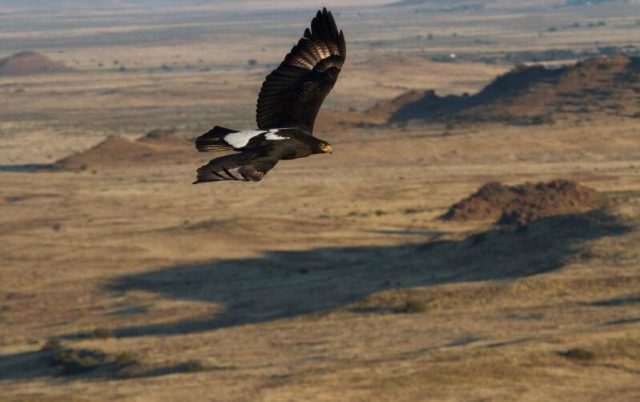New tool helps locate areas for safe turbine development.
THE RAPID uptake of wind energy globally offers hope of a transition towards sustainable renewable energy but it can also present a real threat to soaring birds of prey.
A new tool offers hope of a win-win solution that allows developers to rapidly identify the best locations for their wind turbines while minimising the risk of collision for one special bird of prey, the Verreaux’s Eagle.
The Verreaux’s Eagle is a charismatic bird of prey that is particularly vulnerable to fatal collisions with wind turbines whose outer blade tips spin at speeds of up to 290km/hour. It is unknown as to whether the eagles simply do not see the moving blades or do not perceive them as a threat but in South Africa a considerable number of eagles have already been killed at wind farms.
To minimise these collisions, developers usually try to build wind turbines away from areas that are in ‘high-use’ by birds of prey. Typically, this has involved restricting development within a certain distance of active nest sites. However, these exclusion buffers have proven unsatisfactory for both developers and conservationists.
The VERA computer model
Researchers from the Fitzpatrick Institute of African Ornithology (Fitztitute) at the University of Cape Town (UCT), HawkWatch International and the University of Amsterdam have developed a new tool – the Verreaux’s Eagle Risk Assessment (VERA) model – which offers developers more accurate guidance on where to safely build their turbines.
A study published this week in the British Ecological Society’s Journal of Applied Ecology, describes VERA as a computer model which uses data from GPS tracking devices attached to 15 Verreaux’s Eagles across South Africa.
The study shows that by applying this tool instead of an exclusion buffer, developers can achieve the same level of protection for the eagles and can increase the areas of land available for safe wind energy development by around 20%.
“In short, by using our predictive model to account for habitat use instead of simple buffers around a nest, a greater area of land can be made available for wind energy development without increased mortality risk to raptors,” said Dr Megan Murgatroyd from HawkWatch International and lead author of the study.
Predicting where and how high eagles will fly
Tracking of the eagles started eight years ago, when the first Verreaux’s Eagle was fitted with a GPS tracking device as part of Murgatroyd’s PhD at UCT. The devices were developed at the University of Amsterdam and can provide a record of where and how high the bird is flying every three seconds.
Associate Professor Arjun Amar of the Fitztitute and co-author of the study said: “The data that Megan has been able to collect is unparalleled for any eagle in Africa and has allowed us to build these models. Our aim is to allow wind energy to be developed in a more sustainable manner and to reduce the threat these turbines can pose to this important African species.”
Putting the model into action
There is considerable demand for the model and it has already helped provide guidance on turbine placement for a number of proposed wind farms across South Africa.
Murgatroyd shared: “The best time to run the model is at the very early stages of a project. This way, developers can plan their layouts accordingly from the start instead of having to make major, expensive changes at a later stage.”
She noted that it was encouraging to see how willing developers have generally been in using VERA and taking up the recommendations voluntarily.
“We will now work with Birdlife South Africa to update their guidelines on wind energy and Verreaux’s Eagles. This will help to bring the use of VERA into best-practice guidelines for Environmental Impacts Assessments at all proposed developments where Verreaux’s Eagles are breeding.”








